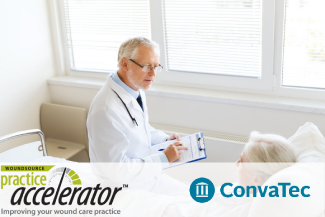Wound Care Options for Surgical Site Management
September 29, 2021
Surgical site care is vital in preventing complications such as infection and dehiscence. Advanced therapies can help in the prevention of infection and the management of surgical sites and wounds. In patients who are deemed at risk, consider beginning the use of advanced technologies earlier in treatment to maximize overall outcomes.
Using Advanced Therapies for Surgical Wound Management
Advanced therapies can help in the management of surgical wounds from a prevention and management standpoint. To achieve most efficacy and best outcomes, clinicians should be familiar with the mechanism of action of the therapies available to them to select the most effective modality.
Clinical data show that utilizing appropriate advanced therapies can help prevent surgical site infection, reduce edema, and promote tissue regeneration and wound contraction in wounds that are stalled and in abnormal healing in the proliferative phase of healing.
How much do you know about managing surgical wounds? Take our 10-question quiz to find out! Click here.
Gelling Fiber Dressings
Gelling fiber dressings support wound healing by absorbing wound fluids while maintaining a moist wound bed, thus helping to provide bacteria balance, promoting autolysis, and aiding in the formation of new granulation tissue. These types of dressings use technology that forms a gel when they meet wound exudate and locks in excess fluid at the same time. This process provides an optimal moist wound healing environment.
Moisture balance and management in surgical sites are imperative. Surgical site incisions that are too wet can become macerated and swollen, and the result may be disruption of the dermal structures. Dressings that incorporate properties to wick or retain moisture, such as gelling fibers or alginates, and/or that donate moisture, such as hydrogels, are essential in an optimal moist wound healing environment for healing progress. These dressings can include hydrogels, alginates, gelling fibers, hydrocolloids, and foams, among others.1
A moist wound healing environment is essential for facilitating the healing process. Maintaining an even balance of moisture has been proven to move wounds toward healing three to five times faster than in dry wounds. Moisture balance improves the aesthetics of the wound, promotes epithelial migration and faster epithelialization, and helps reduce pain.21
Antimicrobial Dressings
Dressings with antimicrobial properties kill or slow the spread of microorganisms and thereby support the prevention and management of biofilm and infection. Biofilms are present in the majority of chronic wounds and cause delayed healing. Antimicrobial dressings contain different antimicrobial substances, delivery systems, absorbency capabilities, wear time, shapes, and sizes. There are also various features of sustained release and antimicrobial effects of up to 48 hours, three days, and seven days Common antimicrobial substances include silver, polyhexamethylene biguanide (PHMB), and iodine.
Silver dressings are antimicrobial dressings that are available in a variety of formats to facilitate a slow release of silver to avoid cytotoxicity and support wound healing by managing bioburden and preventing infection. The clinical rationale for using silver dressings on surgical sites is to reduce antimicrobial burden and prevent infection during healing.31 Silver dressings can also be used as part of an antimicrobial stewardship plan.
Antibiotic resistance is a global problem caused by overprescription of antibiotics. Antimicrobial stewardship is based on appropriate use of antibiotic after results are collected from specimens for culture. Open wounds, such as surgical sites, should be considered colonized with bacteria, and antibiotics should be prescribed only for wounds that are clinically infected.41
Cellular and/or Tissue Based Products
Cellular and/or tissue-based products (CTPs) are effective in partial- and full-thickness wounds of various etiologies. These tissue-engineered products may be biological or biosynthetic. There are a multitude of classifications and characterizations of CTPs, as well as variations in application, considerations after application, shelf life, specification, and physician or surgeon preference. Coverage for CTPs depends on the patient’s insurance and medical necessity.
Negative Pressure Wound Therapy
Negative pressure wound therapy (NPWT) supports and accelerates healing in full-thickness wounds by optimizing blood flow, reducing tissue edema, and removing excessive fluid at the surgical site. NPWT is an economical option for therapy when it is used appropriately.51
Preventing surgical site complications is essential in preoperative and post-operative planning. A preventive approach reduces complications and costs and lessens the hospital stay and suffering of the patient. Utilizing advanced wound care therapies and educating the patient on how to perform consistent hand hygiene, good wound care, and recognize the first signs of wound infection will help enhance overall outcomes.
Conclusion
Clinicians should make sure that they understand the wound and the patient’s needs before selecting an advanced therapy for optimizing outcomes. Patients who are involved in their care can be educated on the importance of essential wound care practices (hand hygiene, dressing changes), on what to expect, and on care planning to promote healing.

References
1. Wu P, Fisher AC, Foo PP, Queen D, Gaylor JD. In vitro assessment of water vapour transmission of synthetic wound dressings. Biomaterials. 1995;16:171-175.
2. Junker JP, Kamel RA, Caterson E, Eriksson E. Clinical impact upon wound healing and inflammation in moist, wet, and dry environments. Adv Wound Care (New Rochelle). 2013;2(7):348-356. doi:10.1089/wound.2012.0412
3. Storm-Versloot MN, Vos CG, Ubbink DT, Vermeulen H. Topical silver for preventing wound infection. Cochrane Database Syst Rev. 2010;(3):CD006478.
4. Lipsky BA, Dryden M, Gottrup F, Nathwani D, Seaton RA, Stryja J. Antimicrobial stewardship in wound care: a position paper from the British Society for Antimicrobial Chemotherapy and European Wound Management Association. J Antimicrob Chemother. 2016;71(11):3026-3035. doi: 10.1093/jac/dkw287. Epub 2016 Jul 25. PMID: 27494918
5. Niezgoda JA. Combining negative pressure wound therapy with other wound management modalities. Ostomy Wound Manage. 2005;51(2A Suppl):36S-38S. PMID: 15699563
The views and opinions expressed in this blog are solely those of the author, and do not represent the views of WoundSource, HMP Global, its affiliates, or subsidiary companies.
The views and opinions expressed in this blog are solely those of the author, and do not represent the views of WoundSource, HMP Global, its affiliates, or subsidiary companies.









Follow WoundSource
Tweets by WoundSource